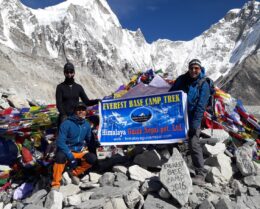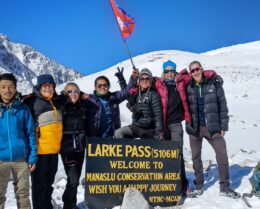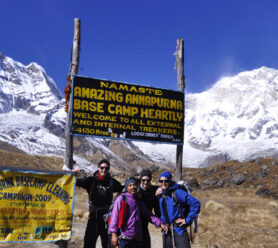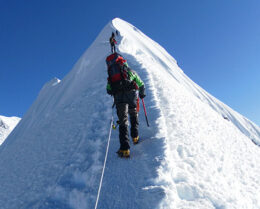Best time for Everest Base Camp Trek
UPDATED ON 16 June, 2023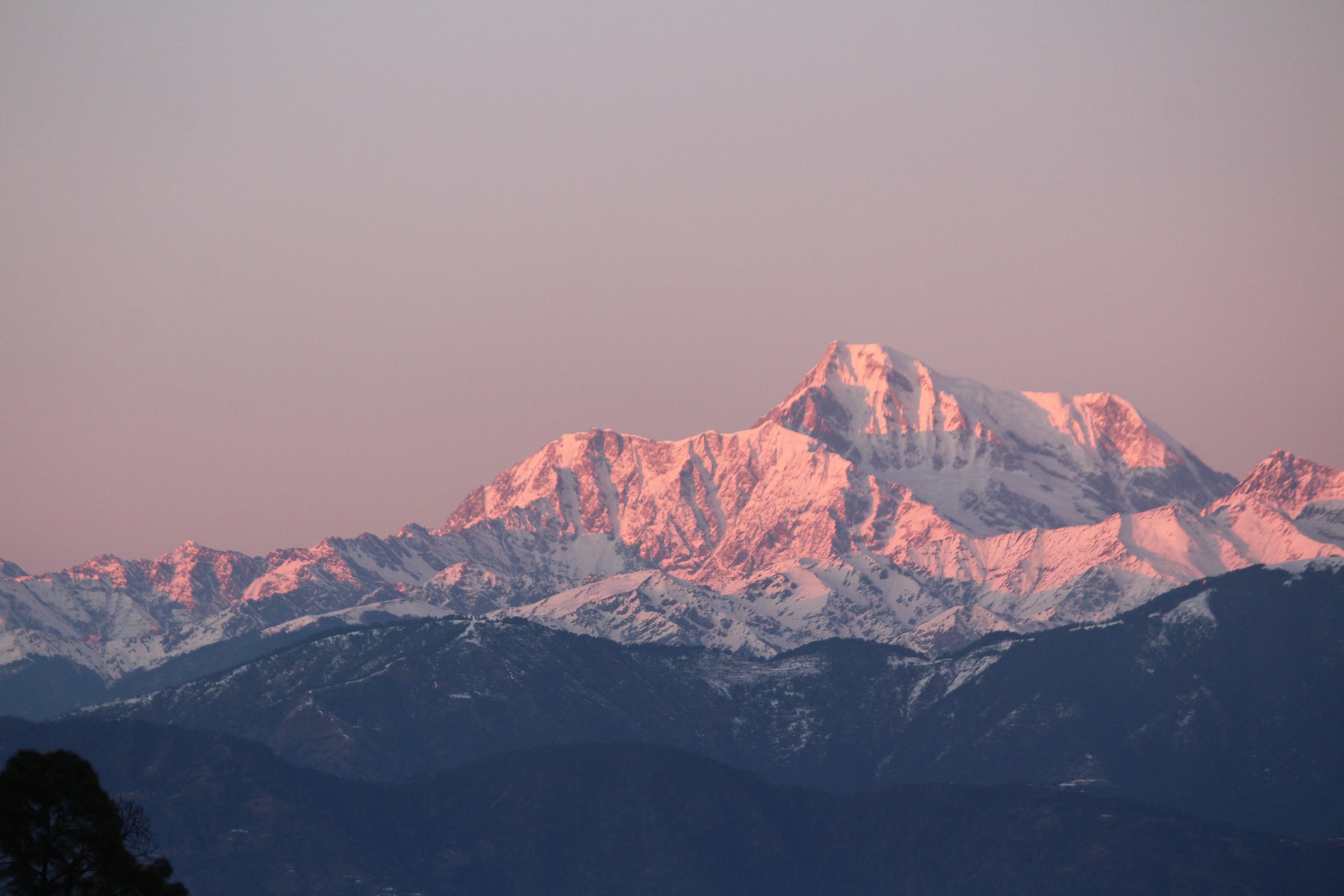
One of the most thrilling and rewarding journeys you can take in Nepal is to the Everest base camp. Being in the vicinity of the highest mountain peak in the world, the majestic Ama Dablam to the south, and the spine-chilling Khumbu glacier with its enormous tunnels that resemble snow caves and its ominous apertures are the first and foremost reasons. There are stunning valleys with preserved traditional villages and Sherpa Buddhist culture flourishing in their own world of high land surrounded by Himalayan peaks, which are encircled by peaks and mountain ranges. Therefore choosing the best time for Everest Base Camp Trek is important.
Annually, a lot of visitors come to visit the Everest base Camp. To get the majestic view of Everest. Traveling to the Everest Base Camp trek during the Spring and Autumn seasons will be best. As it provides the best experience to travelers. Similarly, during this time of the year the surrounding and environment is good to travel.
Everest Base Camp Route Map
You can easily navigate your way to Everest Base Camp by following the route outlined on the Everest Base Camp map. It provides clear directions and shows the path to reach your destination, ensuring a successful journey to the base camp of Mount Everest.
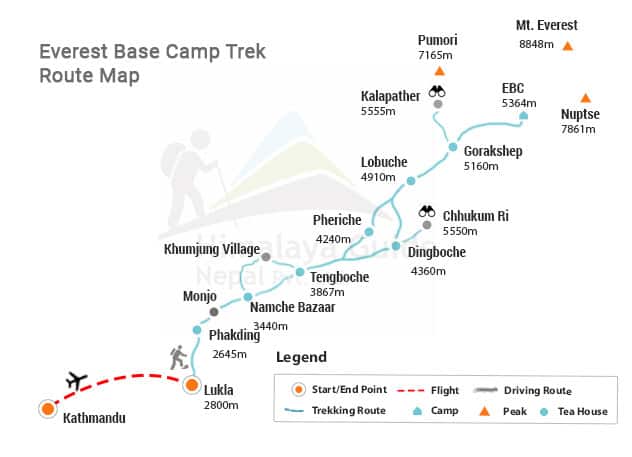
High Season
September to November
From September through November, Nepal offers a beautiful, cloudless sky that allows visitors to the nation to enjoy breathtaking views of the Himalayas from every location. Additionally, now is the ideal time to travel to Nepal and the Best time for Everest Base Camp Trek because it is the period of several significant cultural celebrations, like Teej, Gaijatra, Dashain, Tihar, Chaat, etc. The optimal temperature range is between 15 and 25 °C (59 and 77 °F).
March to May
The second-highest time of year for trekking tourism in Nepal is spring. A good time to trek to Everest Base Camp is also available. In the lowland and at high altitudes, it is only moderately warm. Kathmandu’s capital city experiences an average temperature of 15-20 °C (59-68 °F) throughout this period. After a long winter at higher altitudes, spring is welcomed by a variety of flowering flowers, not just in gardens and parks but also on entire mountain slopes covered in rhododendron variants, Nepal’s national flower.
Low Season
December to February
The winters at the Everest Base Camp are pretty harsh; daytime highs range from 15 to 18 °C while nighttime lows range from minus 10 to minus 15 °C. In addition to the bitter cold, a powerful wind that fluctuates between 10 and 12 mph in January and February causes hurricane spirals to form around the base camp and high passes. Instead, lower-elevation treks are especially well-suited to this time of year. So, it is not the best time for Everest Base Camp Trek as compared to the spring season. The morning and evening remain cool, while sunny days are mild. There are sporadic snowfalls at high elevations but the sky is clear.
Everest Base Camp Trek Cost
The cost of the Everest Base Camp Trek varies depending on the trek’s length, the season, the type of route taken, and the amenities offered. The usual cost of a 12-day climb to the Everest Base Camp, including food, lodging, permits, transportation, and guide/porter services, is between $1,500 and $3,500 per person. Nevertheless, based on your particular needs and tastes, it may be feasible to discover more reasonable or more expensive choices.
Everest Base Camp Permit
To trek to the Everest Base Camp, you must obtain a permit from the Nepalese government. The cost of the permit varies depending on the time of year and the type of permit you need.
The most common type of permit for the Everest Base Camp Trek is the TIMS (Trekkers’ Information Management System) card, which costs approximately $10-$20. In addition to the TIMS card, you will also need to obtain an Everest Base Camp trekking permit, which costs $11 per person per week.
It is important to note that the Nepalese government also requires all trekkers to be accompanied by a licensed guide or a porter. The cost of the guide or porter will vary depending on the company you choose, but it is typically included in the overall cost of the trek.
Everest Base Camp Trek Difficulty
The Everest Base Camp Trek is one of the most popular trekking routes in the world, attracting thousands of adventurers every year. This incredible journey takes trekkers to the base of the world’s highest mountain, Mount Everest, and offers breathtaking views of some of the tallest peaks in the world. However, the trek is not without its challenges and requires a good level of fitness and preparation.
One of the main difficulties of the Everest Base Camp Trek is the high altitude. The trek takes you from Lukla at 2,800 meters to the base camp at 5,364 meters above sea level, and the thin air and reduced oxygen levels can make the trek challenging for some.
Altitude sickness is a real concern and trekkers should be aware of the symptoms, which include headache, fatigue, loss of appetite, and nausea. Therefore, it is important that you travel at the best time for Everest Base Camp Trek.
Another challenge of the Everest Base Camp Trek is the distance. The trek covers a distance of approximately 160 kilometers, which takes between 10 to 12 days to complete.
The trek involves long days of hiking and can be physically demanding, especially at higher altitudes. Trekkers should be in good physical condition and have experience hiking in mountain terrain.
How Hard is EBC Trek
The terrain on the trek can also be challenging, with steep inclines, rocky trails, and uneven terrain. In some areas, the trail can be slippery and trekkers should be careful when navigating these sections. Additionally, the weather on the trek can be unpredictable, with heavy rain, snow, and high winds common during the monsoon season.
Despite these challenges, the Everest Base Camp Trek is an unforgettable experience, and the beauty of the landscape and the sense of accomplishment at the end make it all worth it. To ensure a safe and enjoyable trek, it is important to be well-prepared and to choose a reputable trekking company.
In conclusion, the Everest Base Camp Trek is not for the faint of heart and requires good fitness and preparation. However, for those who are up for the challenge, the trek offers an incredible journey through some of the most beautiful and remote regions of the world and the opportunity to stand at the foot of the tallest mountain on earth.
Everest Base Camp Trek Itinerary
Everest Base Camp is a dream destination for a lot of passionate trekkers and Hikers. Although, the Everest Base Camp trek is a dream destination for so many people. But, finding a suitable itinerary for the trek is very difficult for so many people.
Similarly, there is a lot of traveling company. Likewise, there are a lot of itineraries for the .00Everest Base Camp Trek. However, we at Himalaya Guide Nepal provide you with the best Everest Base Camp itinerary where one can enjoy every beauty of the region and a mesmerizing view of Mount Everest Itself.
Everyone dream to climb Mount Everest but the first ascender of Mount Everest were Edmund Hillary and Tenzing Norgay.
Outline Itinerary for Everest Base Camp Trek
Here is a basic outline of an itinerary for the Everest Base Camp Trek:
Note: The following number represents the number of days one will be spending at Everest Base Camp Trek
1: Arrival in Kathmandu
2: Fly from Kathmandu to Lukla (2860m), then trek to Phakding (2610m)
3: Phakding to Namche Bazaar (3440m)
4: Acclimatization Day in Namche Bazaar
5: Namche Bazaar to Tengboche (3860m)
6: Tengboche to Dingboche (4410m)
7: Acclimatization Day in Dingboche
8: Dingboche to Lobuche (4910m)
9: Lobuche to Gorakshep (5140m) and visit to Everest Base Camp (5364m)
10: Gorakshep to Kala Patthar (5545m) and back to Gorakshep
11: Gorakshep to Pheriche (4280m)
12: Pheriche to Namche Bazaar (3440m)
13: Namche Bazaar to Lukla (2860m)
14: Fly from Lukla to Kathmandu
15: Departure from Kathmandu
Note: This itinerary is subject to change depending on factors such as weather conditions, the physical fitness of the trekker, and altitude sickness.
The temperature at Everest Base Camp
The temperature at Everest Base Camp differs from season to season. Moreover, the temperature in the Everest region can vary greatly depending on the altitude, time of year, and weather conditions. In general, temperatures tend to be lower at higher elevations and can drop below freezing even in the summer months.
At low elevations, such as in the town of Lukla where many trekkers begin their journey to the Everest Base Camp, temperatures are mild and similar to those in many other mountainous regions. During the day, temperatures can reach the mid-teens to low-twenties Celsius (60-70°F) while at night they can drop to below freezing.
As you ascend higher into the mountains, temperatures become increasingly cold and harsh. At elevations above 4,000 meters (13,123 ft), temperatures can drop to well below zero, even in the summer months. During the winter months, temperatures can be especially harsh and can fall to -40°C (-40°F) or lower.
What Happens
In addition to the colder temperatures, trekkers also face the added challenges of strong winds, snow, and sleet, which can make conditions even more difficult. As a result, it is important for trekkers to come prepared with warm clothing and proper gear to stay warm and dry.
One of the most challenging parts of the trek is reaching the summit of Kala Patthar, which is located at an altitude of 5,555 meters (18,192 ft). At this elevation, temperatures are extremely cold, and trekkers must be prepared to face harsh winds and sub-zero temperatures.
In conclusion, the temperature in the Everest region can be highly variable and can range from mild to extreme depending on the altitude, time of year, and weather conditions. It is important for trekkers to be prepared for the cold and to bring the proper gear to stay warm and dry throughout the trek.
Conclusion
Everest Base Camp is possible throughout the year. But, if you travel to the EBC trek then traveling at the best time of the year will make your visit even more enjoyable and fun. Likewise, the best time for an EBC trek is during the spring and Autumn seasons. At this time of the year, the surrounding is clear and the trail is clear. So, hopefully, you know about the best time for Everest Base Camp Trek.
You May Be Interested In:

